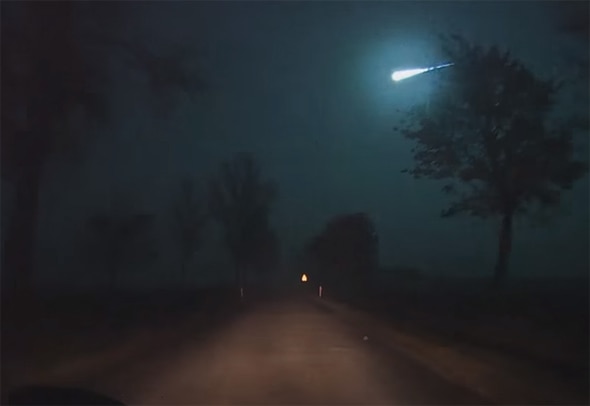Create a free profile to get unlimited access to exclusive videos, sweepstakes, and more!
Very Bright Fireball Over Europe Saturday Night

Saturday night (Halloween) at around 19:00 local time, a smallish bit of cosmic debris entered Earth’s atmosphere and burned up over central Europe. It was very bright, and because it happened in the early evening, a lot of people saw it. Twitter was lit up with reports.
It was seen from south Sweden, Germany, Poland, and as far east as Belarus! Impressive.
Pictures and video started getting posted to YouTube and Twitter as well. Here’s one of the best ones, taken from Poland, that shows the fireball quite well.
As you can see, it gets bright very rapidly, leaves a nice glowing train (the technical term for the trail of glowing debris), and then you see the still-hot solid meteoroid fall away. This is typical behavior for meteors. The solid part (called the meteoroid) is moving so rapidly—usually more a few dozen kilometers per second—it rams the air in front of it violently. A compressed gas heats up, and the shocked air can reach several thousand degrees. This heats the meteoroid up, causing it to glow.
The rush of air past it blows the melted material off (this is called ablation), and that leaves the glowing train. The meteoroid decelerates viciously, falls below the speed where it heats the air up, and then begins its long fall to the ground (assuming it’s big enough to reach the ground). It may glow for a few more seconds, but at 40–80 km high the air is quite cold, and it cools rapidly. It may break apart, raining meteorites down over some area, or big chunks might hit as well. That last part’s rare, though. Unlike movies, where they show small pieces hitting at high speed, the meteoroid(s) slows to terminal velocity, usually a couple of hundred kilometers per hour (or much slower for smaller pieces), for the rest of the trip down.
This video missed the first second or two of the European event, but you can see the sky light up blue-green from it:
A lot of folks say it looked green to them, which means it may have been metallic; nickel glows green when heated to incandescence, and metallic meteoroids are generally mostly iron with several percent nickel. Magnesium can be blue-green as well, and that’s common in stony meteorites too.
On Twitter, I got a lot of people questioning if this was related to 2015 TB145, the 600-meter asteroid/dead comet that passed Earth on Saturday. Almost certainly not; the direction it was moving doesn’t line up, and the difference in time makes it unlikely as well (remember, these things are moving at 20–40 kps, and TB145 passed us many hours earlier; they were separated by hundreds of thousands of kilometers at least).
This video, taken by the Polish Fireball Network, shows it moving roughly SE to NW; note the Big Dipper on the horizon.
As it happens, the annual Taurid meteor shower is ramping up right now. It’s possible this was related; that shower is known for its fireballs. The direction kinda sorta lines up, and the radiant of the shower (the part of the sky from which meteors appear to come) was just on or above the horizon at that time, so it’s possible. But if this fireball was in fact from a chunk of metal, it wasn’t related; Taurids come from an old comet and have essentially no metal. Hopefully we’ll know more soon.
The final question is, how big was the meteoroid? It’s hard to tell. I’d guess it was less than a meter across, but that really is just a guess. Objects that small rarely survive re-entry intact, but again it depends on what they’re made of.
All in all, a nice example of a fireball, and a good reminder that our atmosphere does a great job protecting us from the 100 or so tons of material that hits us every day.
And, of course, a reminder to look up. You never know what you might see.
Wanna learn more about meteors? Here’s my episode of Crash Course Astronomy about them:
Tip o' the Whipple Shield to MissZuza on Twitter; she was the first person to alert me, and she was an eyewitness in Germany!


























